By G. L. Pease
 Once again, the incoming questions are many, varied, and quite interesting. And, fortunately, I’ve got enough good ones to choose from that I haven’t had to resort to making them up, or, worse, answering the sillier questions, like what do I wear whilst working on new blends (a fetching little satin peignoir, with matching fuzzy high-heeled slippers), the color of the first car I owned in which I smoked a pipe (British Racing Green – really), or if it’s true that I’m attempting to grow homunculi in large glass flasks in my attic laboratory (not this year – the weather’s been off). So, let’s get to a few of them, and don’t forget, if you’ve got a burning question, or even something you’re just mildly curious about, send it along, and I’ll add it to the queue. Otherwise, the preceding sentences should offer ample warning about what you may face here in months to come.
Once again, the incoming questions are many, varied, and quite interesting. And, fortunately, I’ve got enough good ones to choose from that I haven’t had to resort to making them up, or, worse, answering the sillier questions, like what do I wear whilst working on new blends (a fetching little satin peignoir, with matching fuzzy high-heeled slippers), the color of the first car I owned in which I smoked a pipe (British Racing Green – really), or if it’s true that I’m attempting to grow homunculi in large glass flasks in my attic laboratory (not this year – the weather’s been off). So, let’s get to a few of them, and don’t forget, if you’ve got a burning question, or even something you’re just mildly curious about, send it along, and I’ll add it to the queue. Otherwise, the preceding sentences should offer ample warning about what you may face here in months to come.
This came from Kevin: Why are some Burley blends strong in nicotine and have a strong ash taste (usually the boutique blends) and other straight burley blends, like the mass market blends are extremely mild in taste and deliver no nicotine buzz? It is my understanding that burley commonly has one of the highest nicotine and ash levels, so how do the mass market guys get it to be so mellow and mild?
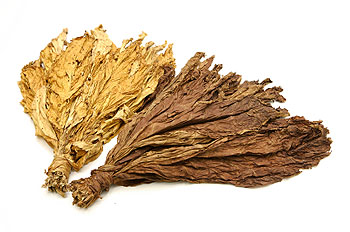 A: By themselves, burley tobaccos tend to be a bit harsh, sometimes astringent, and possessing of the dreaded "Burley Curse," an unpleasant harshness, usually in the back of the throat, as the bowl is smoked. Most air-cured leaf is high in nicotine and other nitrogenous compounds, and low in sugar, and therefore burns with a higher pH, producing a more alkaline smoke. When the smoke is more alkaline, the nicotine carried in the smoke-stream is more readily absorbed through oral membranes, so the delivery of the nicotine into the bloodstream is more efficient and more immediate.
A: By themselves, burley tobaccos tend to be a bit harsh, sometimes astringent, and possessing of the dreaded "Burley Curse," an unpleasant harshness, usually in the back of the throat, as the bowl is smoked. Most air-cured leaf is high in nicotine and other nitrogenous compounds, and low in sugar, and therefore burns with a higher pH, producing a more alkaline smoke. When the smoke is more alkaline, the nicotine carried in the smoke-stream is more readily absorbed through oral membranes, so the delivery of the nicotine into the bloodstream is more efficient and more immediate.
By adding sugar to the tobacco, a couple of things happen: The tobacco will produce a more acidic smoke, perceived by the smoker as "milder," and mitigating the curse. Additionally, though roughly the same amount of nicotine is present in the smoke-stream (some can be lost thorough processing), it will not be absorbed as readily.
But, that doesn’t mean you’re off the hook. Some of the nicotine is dissolved in the saliva, and subsequently swallowed, where some it will begin slow infusion into the bloodstream through the gut. By the time you notice the effects, it’s usually too late, and depending on your tolerance, what you’ve eaten, and how much you’ve smoked, you might look forward to a couple hours-long E-ticket ride on the Whirl-and-Hurl. It can be pretty unpleasant. So, you may not get the same nico-rush, but you can still suffer the bad effects if you go over the edge.
Interestingly, some of the same things can happen with blends heavily loaded with oriental tobaccos. Though the orientals have low nicotine content, typically, they’re also not very sugary, so their smoke can sometimes be more alkaline than their straight virginia comrades. A tobacco with lots of oriental leaf may not have a particularly high actual nicotine content, by percentage, but the delivery might be made efficient enough by the higher pH to make the blend seem stronger than it is.
A little free advice? When experiencing any new tobacco, approach with caution until you’ve gauged its strength in relation to your own body chemistry, and when you get that ashy, sharp, nicotine infused thing happening in the back of the throat, slow down.
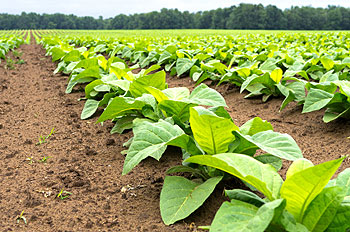 From several folks: I keep reading that some blenders age their tobacco for years before selling it, and others sell their blends "green." What’s really up with that?
From several folks: I keep reading that some blenders age their tobacco for years before selling it, and others sell their blends "green." What’s really up with that?
A: That’s a tricky one, so I’ll treat the easy part first. No one in this business sells green tobacco. We don’t even get green tobacco. By the time the leaf is delivered to our receiving docks, it’s been thoroughly cured and aged for a minimum of 18-months. In rare cases, it’s not at its prime, yet, but it’s certainly far from green.
Green tobacco is unsmokable by anyone not blessed at birth with an asbestos tongue. It’s harsh, acrid, bitter, and bites like Cujo on amphetamines. It may make great insecticide, but it’s lousy as smoking tobacco, at least until it’s been properly aged. We blenders don’t get that. The leaf we get is ready to process and blend. Of course, once it’s blended, it benefits from a few months of resting time in the tins, but most of us cannot afford the luxury of doing so, and few consumers would be willing to pay the increased prices for the product.
But, didn’t the "old guys" age everything before selling it? And, isn’t the shortage of some of the UK-produced tobaccos a result of their aging it?
This is one of those old songs that gets sung like a Row Your Boat round over the interwebs every few months. Here’s how it really works, and how it’s always worked, albeit from a US-centric perspective.
Manufacturers on the other side of the puddle make the stuff, tin it, sell it to distributors, and ship it as soon as possible. They cannot afford to sit on inventory. It ties up leaf and labor, it ties up real estate, it ties up capital. Distributors don’t like to sit on tobacco, either, so they generally try to balance their ordering to keep the pipeline flowing, but not so much that it’ll sit around for months. Sometimes, they screw up, and stuff ends up aging in warehouses. Still, not something the manufacturer did.
 Being conveniently located in the US, domestic producers can get their product to US retailers within days of its manufacture. This is both blessing and blight. The European and UK houses, on the other hand, ship their product by sea to US distributors, which takes a bit longer. (Yes, people still "ship" things overseas. Air freight on a few tens of thousands of tins of tobacco is pretty spendy. When we ship a palate load to our foreign distributors, it goes by boat, too.) Their tobacco goes from the manufacturing floor to a bonded warehouse until it’s sold, hopefully quickly, then generally to a freight forwarder, where it will sit until a container can be filled. That container then gets loaded onto a cargo vessel, and can spend a few weeks to a couple months sailing around the world before arriving at its destination port in the US. The tobacco will then generally sit in customs for a week or more. Then, it goes from customs to to a distributor, usually by truck, then, eventually, to the retailer, and finally, to the customer. By the time you get it, what left the manufacturer days, or possibly weeks old, can be several months old. Aged at sea. Aged in warehouses.
Being conveniently located in the US, domestic producers can get their product to US retailers within days of its manufacture. This is both blessing and blight. The European and UK houses, on the other hand, ship their product by sea to US distributors, which takes a bit longer. (Yes, people still "ship" things overseas. Air freight on a few tens of thousands of tins of tobacco is pretty spendy. When we ship a palate load to our foreign distributors, it goes by boat, too.) Their tobacco goes from the manufacturing floor to a bonded warehouse until it’s sold, hopefully quickly, then generally to a freight forwarder, where it will sit until a container can be filled. That container then gets loaded onto a cargo vessel, and can spend a few weeks to a couple months sailing around the world before arriving at its destination port in the US. The tobacco will then generally sit in customs for a week or more. Then, it goes from customs to to a distributor, usually by truck, then, eventually, to the retailer, and finally, to the customer. By the time you get it, what left the manufacturer days, or possibly weeks old, can be several months old. Aged at sea. Aged in warehouses.
Of course, there’s always the possibility that a particular blend just isn’t popular in a particular market, and it can sit on distributor’s warehouse shelves waiting for some retailer to finally order it. But, that’s got nothing to do with the manufacturer, either.
So, why is there a shortage of certain UK tobaccos right now? Either they haven’t made any in a while, or there’s a problem with the distributor, or it’s on a boat. I’d bet a sixpence to a scone they’re not stacking it on shelves, "aging it" before they send it out.
 From Clanobucklin: I am wondering why pipes taste funky after you let them sit for more than a couple of hours? If I am smoking one bowl after another – the pipe usually smokes well – before it gets grouchy 2-3 bowls seems to be the norm before the smoke quality starts to deteriorate.
From Clanobucklin: I am wondering why pipes taste funky after you let them sit for more than a couple of hours? If I am smoking one bowl after another – the pipe usually smokes well – before it gets grouchy 2-3 bowls seems to be the norm before the smoke quality starts to deteriorate.
However, even if I sit a pipe down for more than a couple of hours – a horrible acrid, acidic taste forms in the pipe – thus contaminating my next smoke and trashing my palate. I keep my pipes clean, let them rest, rotate them well – yet this phenomenon seems to be prevalent. Any thoughts and suggestions?
A: A great question, and I’m sure one that many will resonate with as soon as they read it. Not all pipe tobaccos will exhibit the same intensity of acridness if you set the pipe down for a few hours and re-light, but many will. As you smoke, there are lots of byproducts of combustion, one of which is water vapor. Some of this vapor, and dissolved molecules in the vapor, will condense in the lower part of the bowl. When you put the pipe down for any length of time, some of those distillates will oxidize, in some cases, creating additional byproducts that are harsh and cruel tasting. In this respect, the pipe is very much like a cigar, and we all know how bad those can smell when they’ve been sitting around for a while. Frequently, you don’t even have to re-light to know what you’re facing; the smell alone can be brutal.
Not all pipe tobaccos will exhibit this phenomenon equally. In fact, there are many adherents to the so-called Delayed Gratification Technique (DGT) who feel that the tobacco delivers its best if lit, then allowed to stew in its own juices for a while before being re-lit and smoked to the conclusion. (I’m not one of these. Though I’ll sometimes set a pipe down, and return to it later out of necessity, I can’t bring myself to do this on purpose. I do, however, often leave a few minutes between the charring, or false light, and the first full lighting of the bowl, and feel this can enhance the smoking.)
You can do things to help prevent or at least minimize the phenomenon, if you find you’re forced to put your pipe aside for a long time. First, make sure to run a couple of pipe cleaners through the stem and shank to wick up any moisture that’s condensed in the airway. Then, tamp lightly to settle the ash. Finally, don’t leave the pipe any longer than absolutely necessary, and when you come back to it for the relight, blow VERY gently through the stem first – if ashes fly out, you’ve blown too hard. Then, light gently and evenly, finish the bowl, and don’t do it again.
From Dunc in the UK: I have often wondered how Maduro wrapper leaf and Latakia would marry together. Perhaps with a VA for some added natural sweetness. What would be your opinion Greg?
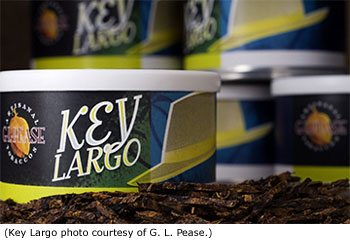 A: My opinion is that it would be a lot like Key Largo!
A: My opinion is that it would be a lot like Key Largo!
Bobby G. asks: During my many years of pipe smoking I have smoked a lot of different blends, some are enjoyable and some are not. Among the "nots" are in the main, aromatics that just don’t suit me.
There is an old blend that at one time was considered a drug store tobak and that is Edgeworth, a tobacco I would always return to after smoking other stuff. I recall Edgeworth Jr as being a fine smoke, at least to me. The so called "Ready Rubbed" was the most plentiful and of course the slices were particularly nice.
Sadly now the blend in any form is not being produced and frankly, that makes me both sad and mad. I’ve had suggestions to try a certain blend that’s "just like" Edgeworth, but it’s not.
How about you sir, any suggestions for an old Edgeworth smoker and I’m not kidding about the "old."
A: Years ago, I had a complete and mostly unapologetic loathing for anything containing burley in more than subtly detectable amounts. Then, a friend sent me a well-aged tin of Edgeworth Slices, and I was forced to eat a double-slice of humble pie. The stuff was superb, and very simple. Just high-grade burley leaf, cased with the right stuff, then pressed and sliced. But, the whole was so much more than the sum of the parts, and that taste and aroma haunts me to this day. I’m exploring some things along those lines, now, and while it’s too soon to say what might come from my experimentation, it could well end up something similar to to those delectable slices! Cross fingers, please.
And, finally, Nostradomus asks: Is the world really going to end in Dec of 2012?
A: Yes, it is. Be sure to smoke up all your tobacco before then, since it’s just going to burn up, anyway. Then, when it actually doesn’t end, please be sure to buy plenty of G.L. Pease tobaccos to restock your bomb shelter. Thank you in advance for your kind support.
-glp
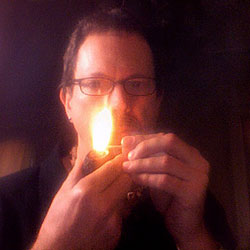
Since 1999, Gregory L. Pease has been the principal alchemist behind the blends of G.L. Pease Artisanal Tobaccos. He’s been a passionate pipeman since his university days, having cut his pipe teeth at the now extinct Drucquer & Sons Tobacconist in Berkeley, California. Greg is also author of The Briar & Leaf Chronicles, a photographer, recovering computer scientist, sometimes chef, and creator of The Epicure’s Asylum. |








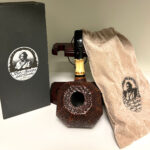

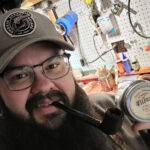





Great questions and great answers, I always enjoy this column
Very nice and informative posting. It was a definite enjoyable read to see some of the answers to things I’ve thought about as well.
I bet all the time it takes for overseas produced blends to get into the hands of U.S. consumers was something a lot of people didn’t realize. What’s ironic is that a lot of those blends often contain U.S. grown tobaccos. So the tobacco goes from the U.S. to Europe and then back again.
Now that I read the answer on the burley blends, it makes total sense. I should have figured that one out myself.
Excellent !!
Thanks Greg for your informative replies (and your Nostradomus answer gave me another way of explaining to my wife why I buy a lot of your products even though I already have plenty on hand!)
Ah-Ha! I cought that little piece about working on something similar to Edgeworth! Hot Damn! Been smokin’ a pipe for almost 40 yrs now and those burleys sure can be an ornery tobacco.
“…harsh and cruel tasting…”
I love your way with words.
This is a fantastic series and it is getting better and better.
Thanks, gentlemen, for the kind words!
Excellent column. many of the questions asked I’ve wondered about myself. Thanks Mr.Pease, greatly appreciated!!
Funn
Greg, your posts are an absolute delight to read, experienced words from a true conoisseur. Thx.